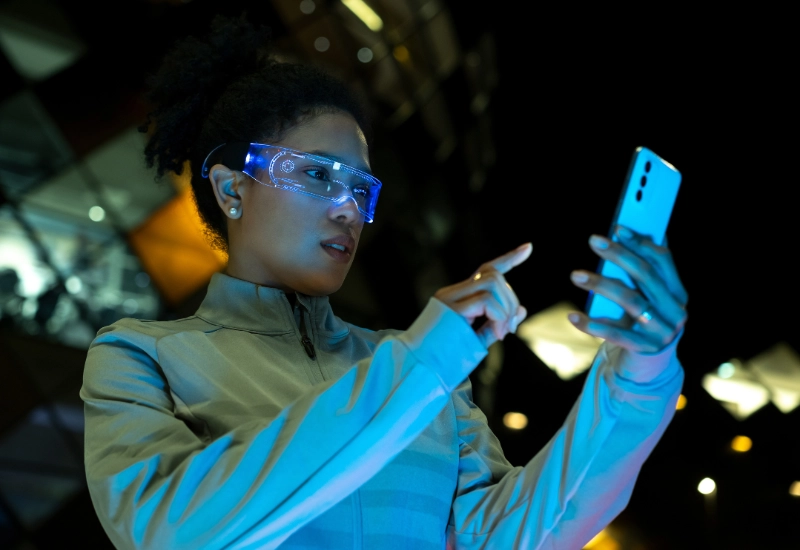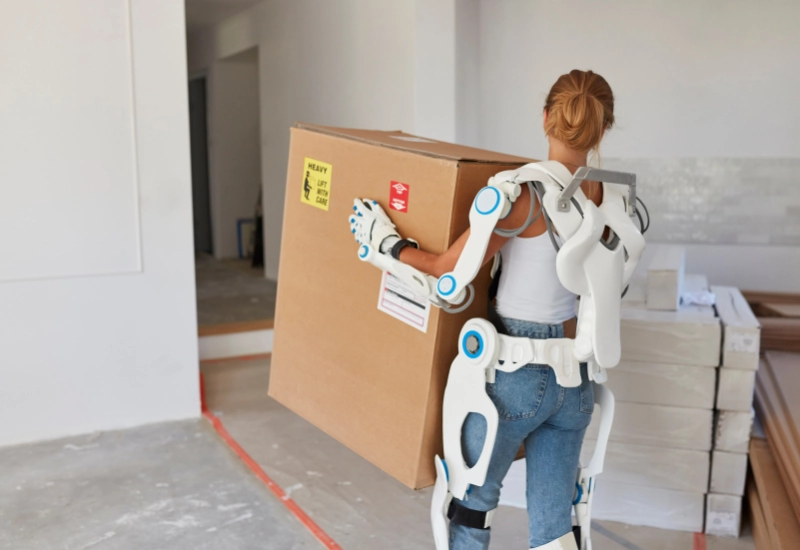Read our updated article: 2025’s Top Advancements in Safety Technology
Safety wearables have become increasingly important in the last few years. These innovations are incredibly beneficial to both employers and workers when appropriately used. Not only can wearable safety technology prevent accidents and injuries from occurring, but it can also collect crucial data for movement and body positions, environmental factors, biometric data, auditory data and other forms of important worker data. This fosters a symbiotic connection between workers and data, enhancing safety leadership and cultivating an optimal workspace. This article details several pertinent wearable safety technologies available today.
Augmented Reality Glasses
Augmented reality (AR) glasses are a wearable technology that can be used in many situations and are especially innovative regarding safety. AR glasses can be implemented into work situations to display helpful metrics and data inside the lens while one is working. This technology also utilizes built-in cameras to share and display real-time data as workers are at their stations. In addition to data such as biometrics and location, the technology is hands-free which is incredibly beneficial in a work setting such as in industrial or manufacturing environments.

Realwear currently has a related wearable technology that is an excellent safety solution for industrial environments. This technology connects workers to experts instantly to work through situations or issues in real time to formulate solutions. There are several benefits involved with this technology which include real-time collaboration, increased productivity, visualization of IoT data, quality improvement, and more.
Environmental Monitoring
Wearable technologies are frequently used for environmental monitoring. A great example of this is air quality monitoring/testing. Workers typically are assigned a device at the beginning of their shift and required to wear it for a certain portion of their shift to collect data about the air quality in the area they are working. The device collects this data over the workers’ shifts and can detect any unsafe air conditions that workers may be exposed to. Examples of unsafe conditions that the technology can detect include gas and other potential contaminants in the air around a workstation. Industrial Scientific is one of the top leaders in the world when it comes to wearable technology for gas detection in an area. TSI is another company that offers several products in the air monitoring space.
Proximity Warning
Proximity warning sensors are used to determine if workers have become too close to each other or, more dangerously, if they have become too close to vehicles. This technology can also be used on vehicles to ensure they do not come too close to pedestrians. Proximity warning sensors typically utilize technology such as lasers, radio frequency, infrared sensors, and Bluetooth sensors to determine if a pedestrian or vehicle is within an unacceptable or dangerous range of the person wearing the sensor at that time. Rombit offers a sensor that prevents pedestrian versus vehicle incidents from occurring.
Worker Vital Sign Monitoring
Worker vital sign monitors are used across many industries to capture physiological data about the worker wearing the monitor. These monitors can capture data including pulse, breathing data, body/skin temperature, and more. This data is collected and used to keep workers as safe as possible and to ensure that the data points in any area do not reach dangerous levels.
Lone Worker Monitoring
In some situations, workers are alone in a workspace or work field. There are monitors available that track data related to the lone workers to ensure their safety. These monitors essentially act as a safeguard to keep in touch with and keep track of a lone worker in terms of data. These monitors also track data that could potentially indicate that the worker is in harm’s way. An excellent example of this technology is a sensor produced by BlacklineSafety. This monitor is worn by the lone worker to ensure that data is tracked in regard to the worker’s safety. If the lone worker finds themself in danger, they are immediately connected to a live person to determine the extent of danger and provide necessary assistance to the worker.
Worker Ergonomics
According to Merriam-Webster, ergonomics is “an applied science concerned with designing and arranging things people use so that the people and things interact most efficiently and safely.” The role of wearable technology in ergonomics is to keep the human body as safe as possible from an ergonomic standpoint during work activities. This can be related to body posture, body position, weights and sizes of objects or parts being lifted, awkward work positions, and other various ergonomic aspects. Worker ergonomics can affect worker safety, injury prevention/reduction, production, quality, and worker satisfaction with their work tasks. StrongArm offers technology to improve worker ergonomics through the identification and tracking of ergonomic risks workers are subjected to.

Exoskeletons
Exoskeletons are one form of ergonomic safety technology. In contrast to other forms of ergonomic technology, these devices enhance and support workers while other devices may simply just be implemented to help a worker maintain proper posture, positioning or movements to prevent musculoskeletal disorders or injuries from repetitive tasks. They can be either mechanical or electric. Mechanical exoskeletons redistribute weight while electrical exoskeletons can enhance the worker’s strength. Exoskeletons alleviate strain while allowing for the precision of a human to perform the task with additional help from either powered or unpowered exoskeleton equipment. Ottobock produces mechanical exoskeletons for simple, repetitive tasks. Sarcos produces electrical-powered exoskeletons that can significantly enhance workers’ abilities.
Smart Hard Hats
Traditional hard hats were created to keep workers safe while onsite and at risk of materials either falling on their heads or the risk of running into objects and injuring their heads. Smart hardhats still retain all of those original safety features but add several technological advances. Smart hard hats are very beneficial in allowing clear, quick communication between workers, supervisors and during emergencies. This technology is not an additional piece of equipment that is attached to the hat, but rather this technology is already built into the hat itself. SmartCap and WakeCap are all producers of high-quality, smart hard hats that can be safely used in the field to protect workers.

In conclusion, the future of wearable safety technology is astonishingly bright for both manufacturers/producers of this technology as well as for the actual users of this technology. With the developments in wearable safety technology, especially concerning the ability to manufacture units to be smaller, this miniaturization allows for devices to serve multiple purposes simultaneously moving forward. SlateSafety’s technology can be used for multiple purposes to keep workers as safe as possible every day. An excellent example of this is the BAND V2 which crosses into multiple category types. It allows for real-time alerts, worker vital sign monitoring, proximity detection, and possibly even more. Stay tuned for more incredible improvements in the wearable safety technology space.

